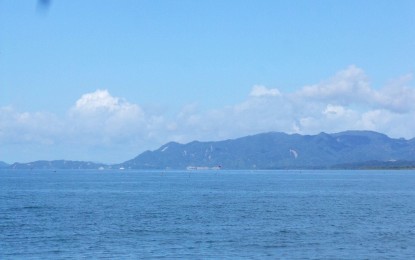
RED TIDE ALERT. A portion of Carigara Bay in Carigara, Leyte. Red tide organisms have remained in five Eastern Visayas bays as frequent rainfall hit several parts of the region in the past weeks, the Bureau of Fisheries and Aquatic Resources (BFAR) reported on Friday (Dec. 3, 2021).(PNA file photo)
TACLOBAN CITY – Red tide organisms have remained in five Eastern Visayas bays as frequent rainfall hit several parts of the region in the past weeks, the Bureau of Fisheries and Aquatic Resources (BFAR) reported on Friday.
BFAR 8 (Eastern Visayas) Director Juan Albaladejo said the downpour has triggered the runoff of pollutants from the uplands to the sea.
“This recurrence of red tide might be due to the series of massive rains. This caused runoff of soil sediments rich in organic load that fertilized the cyst of red tide and triggered the sudden appearance of red tide events,” Albaladejo said in a message sent to the Philippine News Agency (PNA).
Based on laboratory examination results of shellfish meat samples, the toxic organism was found in Carigara Bay in Capoocan, Carigara, Barugo, San Miguel, and Babatngon in Leyte; coastal waters of Guiuan, Eastern Samar; Matarinao Bay in General MacArthur, Hernani, Quinapondan, and Salcedo in Eastern Samar; Cancabato Bay in Tacloban City; and coastal waters of Calbayog City in Samar.
The BFAR has stepped up its monitoring of these coastal waters and reactivates its information drive system to alert the public and inform affected local government units.
Albaladejo requested local government units in these bays to also heighten their watch against the gathering, trading, and consumption of shellfish to prevent paralytic shellfish poisoning (PSP).
PSP occurs after ingesting bivalve shellfish, such as mussels, oysters, and clams, which contain toxins.
Symptoms include tingling of the lips and tongue, which may begin within minutes of eating toxic shellfish or may take an hour or two to develop.
This may progress to tingling of fingers and toes and then loss of control of arms and legs, followed by difficulty in breathing.
Fish, squid, shrimp, and crabs harvested in these areas are safe to eat “provided that they are fresh and washed thoroughly and internal organs, such as gills and intestines, are removed before cooking.” (PNA)
Source: Business Diary Philippines



0 Comments